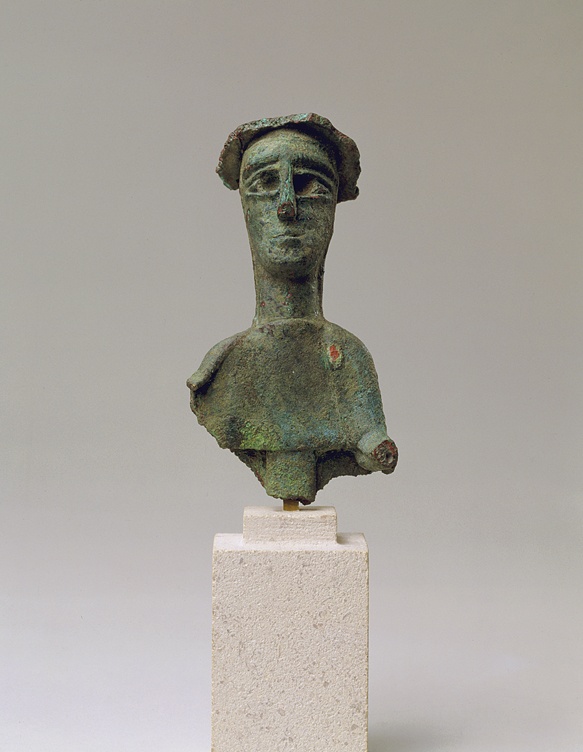
Bronze
H: 10 cm
Allegedly from near Uta
Nuragic
10th-7th century B.C.
Solid-cast by the lost wax method, touched up in the cold and burnished. The hollow eyes probably once inlaid.
Condition: green patina dulled by traces of brownish earth deposit, spots of reddish purple, and green cuprous chloride.
The whole brim of the hat chipped off, a section on the right side broken off and restored. The left forearm and the right arm from above the elbow with fold of cloak missing as also the whole lower body and cloak from the waist downwards.
She stood as did her consort (cat. no. 176) with her right hand raised in a gesture of prayer or adoration in front of a divinity. Her left hand extended forward surely held either a bowl, a loaf of bread or a dish with offerings. The same characteristics must apply to her comparison, the "Donna orante" in Cagliari [1], 17 cm high. The preserved height of our Lady with a Hat is 10 cm and if one restores her with the same proportions as the "Donna orante", they appear to be almost of identical size.
Her hat, fragmentary as that of the "Donna orante", also resembles it. Conical in shape, they rise in smooth concentric zones to a knob on top, with vertical striations in the case of the comparison. Both Lilliu and Thimme think that their headgears were originally a sort of large sombrero, such as the one on the statuette in Copenhagen [2] or the hat on a head in Cagliari [3] which Thimme describes as having an upturned brim in front, but which from the photo seems to us to be a deformation due to damage. It gives the impression, from the way it is placed on the head, of having been made of straw, which may have been sewn to the veil to secure it. These veils cover the ears, the back of the heads and end beneath the mantles; on the present example and the "Donna orante" they are identical and both veils are similar to the one worn by the statuette in Copenhagen.
As her comparison, she is clad in a close-fitting dress which probably ended in two broad hems and a garment girt at the waist and folding over in a kolpos. Like her consort (cat. no. 176) and the related figures, she wears a mantle [4] .
Exhibited and Published:
Kunst Sardiniens, cat. no. 143, pp. 393, 303 ill.
Mentioned:
Jurgeit, F.: Beobachtungen zu einigen sardischen Gewändern, in: Antidoron J. Thimme (Karlsruhe, 1982), pp. 119-124, ill. 2.
Archaeology Glossary
1 See cat. no. 176 and footnote 6.
2 National Museum, Dept. of Antiquities: Lilliu, G.: Sculture della Sardegna nuragica (Verona, 1966), no. 80, pp. 154-156.
3 Lilliu, G.: op. cit., no. 81, pp. 156-157; Thimme, J.: Kunst Sardiniens, no. 144, pp. 393-394, 303 ill.
4 For a thorough discussion on Sardinian garments, see Jurgeit, F.: Beobachtungen zu einigen sardischen Gewändern.